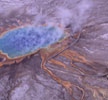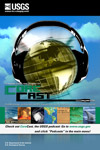USGS CoreCast
It's natural science from the inside out.
USGS Podcasts Home > CoreCast Home Page
Can't see Flash? Install Flash Player.
Next page
|
80
|

Yellowstone National Park has experienced several hundred small earthquakes in the past few weeks. So what's going on? Dr. Jake Lowenstern, USGS Scientist-In-Charge at the Yellowstone Volcano Observatory, tells us what's happening and how scientists monitor volcano and earthquake activity at Yellowstone. (8:08) | Transcript/Links | |
|
79
|

In this episode: California wildfires, the Great Southern California ShakeOut earthquake preparedness drill, landslide potential, and a magnitude 7.5 off the coast of Indonesia that prompts fears of a tsunami. (4:31) | Transcript/Links | |
|
78
|

Safe drinking water supplies are critical to maintaining and preserving public health. But how healthy is that resource? A recent USGS study found low levels of man-made chemicals in water entering and leaving drinking water treatment plants. USGS lead scientist Greg Delzer explains the findings of this study. (7:42) | Transcript/Links | |
|
77
|

More accurate predictions of future climate and improved understanding of today’s warming are possible with new data from the first comprehensive reconstruction of an extreme warm period. Past warm periods provide real data on climate change and are natural laboratories for understanding the global climate system. USGS scientists Harry Dowsett and Marci Robinson discuss this research and implications. (7:08) | Transcript/Links | |
|
76
|

Secretary of the Interior Dirk Kempthorne and USGS Director Mark Myers reflect on the successes of The Great Southern California ShakeOut—the largest earthquake preparedness drill in U.S. history. (11:31) | Transcript/Links | |
|
75
|

Earthquakes can be far more than just geological phenomena—they can greatly alter the way we live. In this video, "The Great Southern California ShakeOut: An Earthquake Scenario Based On Science," USGS scientists and their partners talk about the ways science is used to help build safer communities in Southern California. Play Video: (downloading may take some time due to file sizes) (15:03) | Transcript/Links | |
|
74
|

The USGS estimates that there are 85.4 trillion cubic feet of undiscovered, technically recoverable gas from natural gas hydrates on the Alaskan North Slope. This is the first-ever resource estimate of technically recoverable natural gas hydrates in the world. This assessment shows that gas hydrates could add significantly to the U.S. energy mix. The Alaskan North Slope holds one of the nation’s largest deposits of technically recoverable natural gas. USGS Director Mark Myers and USGS scientist Timothy Collett discuss the assessment and its results. (8:51) | Transcript/Links | |
|
73
|

USGS scientist Ken Hudnut fills us in on how science created the theoretical magnitude 7.8 earthquake behind the Great Southern California ShakeOut—the largest earthquake preparedness drill in U.S. history, coming Nov. 13—and what such an earthquake would do to downtown Los Angeles. Play Video: (downloading may take some time due to file sizes) (5:58) | Transcript/Links | |
|
72
|

A blazing start to the southern California wildfire season! A number of powerful and destructive earthquakes around the world! The largest earthquake drill in US history just around the corner! (5:11) | Transcript/Links | |
|
71
|

Early this morning, October 29, 2008, a magnitude 6.4 earthquake struck near Quetta, Pakistan. Twelve hours later, a second 6.4 struck in the same area. Dr. Harley Benz, Scientist-in-Charge at the USGS National Earthquake Information Center, fills us in with the details. (7:55) | Transcript/Links | |
Next page


